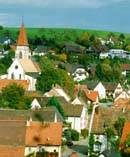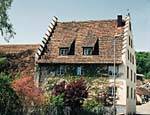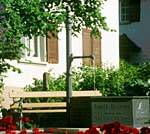Büßlingen
In the first document from the year 830 Büßlingen was named "Pusilinga". This name traces its origin back to the proper noun "Pusilo", the name of the head of the tribe or that of the place centre of the Alemannics settling there.

A jewel in the village is the so called "Schlössli" standing at the place where the Schaffhauser Street and the Zollstreet cross. A plaque at this building bearing the date 1610 shows Jakob Ritzi to be its owner.

The church, St Martin, in Büßlingen is one of the oldest churches of the region; there had already existed a parish around the year 1100. In 1893 the nave was rebuilt and extended. In 1905 the old essential part of the church tower as well as the choir stalls were converted into neo-Gothic style.
The originally agriculturally characterized village has developed into a neat place of residence with a kindergarten, a primary school and a multipurpose hall called "Körbeltalhalle". The end of the village Büßlingen borders directly on the Swiss place Hofen.

The Roman Estate
In the year 15 BC Drusus and Tiberius, the two adopted sons of the Roman Emperor Augustus, conquered in two parallel running campaigns against Celtic alpine peoples as well as today's Switzerland. In the following 50 years the Roman sphere of power had been extended in our region up to the Swabian Alb and to the river Neckar.
Until the middle of the third century AD the area in German's Southwest remained in Roman hand. The population's as well as the Roman army's supply of agricultural products was guaranteed by several estates (villae rusticae) . Those were run by deserving ex-servicemen of the Roman army as well as by locals. The size of one estate amounted maximally 100 hectares (this was seldom); usually the estates were smaller. Compared with other areas, the Büßlinger estate with its nine buildings in all is the second largest Roman estate of Baden-Württemberg and Bavaria. In addition to the upper chamber a temple, a house of a workman-as well as several working quarters were uncovered. In 1982 the renovation of these buildings and the development of ways were brought to a close.
